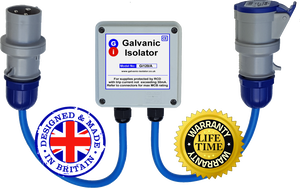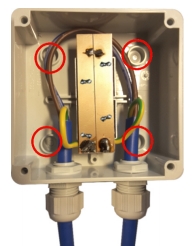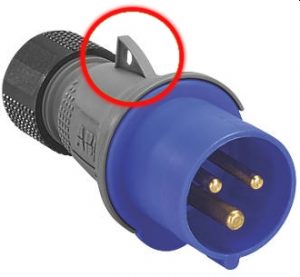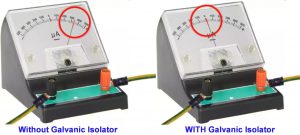Here's an in depth look at our Gi-120/BK/A model Galvanic Isolator / Marine Galvanic Isolator
 The model number hardly rolls off the tongue, but we'll just call it the "BK/A". In fact, it's one of our most popular models,
The model number hardly rolls off the tongue, but we'll just call it the "BK/A". In fact, it's one of our most popular models,
Designed for mounting on a bulkhead outside the boat, the BK/A is housed in an ABS housing about 4" square, and 1.5" deep. It has two compression glands that the cables exit through, and these maintain the IP65 rating of the enclosure.
Two cables connect it to your boat, and these are fitted with the standard 16A connectors, sometimes known as Site Connectors, or Commando Connectors. Whatever you call them, they are fitted to about 95% of boats in the UK, and a very high percentage of vessels worldwide.
Connecting this isolator to your boat couldn't be easier. One connector goes into the electric inlet of your boat, while the other connector goes into the end of your electric hook up cable. Of course, it could also be fitted at the shore end of the hook up cable. It's equally effective at either end. No... there is no difference! Fit it at whichever end you prefer.

This Galvanic isolator is designed to be mounted on to a surface, such as the bulkhead of a boat. You can do this using an adhesive mastic, or by removing the lid, and fixing through the screw holes shown in the photo. Either way is easy enough, but if you're using the mastic option, you'll need to support the Galvanic Isolator until the mastic has cured. All the usual advice about mounting to a clean, dry, dust free surface applies here.

There's no wiring in as such, just push the Galvanic Isolator's connectors into the connectors on your boat. The only thing to mention here is that you need to make sure that the connectors are pushed fully home, so that the cover on the female hooks over the nib on the male.
This is a "Fit & Forget" Galvanic isolator, so there's nothing to check, and no maintenance to perform. It seems almost TOO easy, but there really isn't anything else to do.
Does it work? YES! But of course, you'll only SEE how well the isolator is working when you check the metalwork at and below the waterline. However, if you have the right equipment, you CAN measure the Galvanic Current in the earth conductor of the hook up cable using a sensitive meter called a Galvanometer. In our test, WITHOUT the Galvanic Isolator in circuit, (i.e., shorted out), the Galvanometer showed about a 3/4 scale deflection. WITH the Galvanic Isolator in circuit, there was no noticeable deflection of the Galvanometer. A simple test, and hardly under laboratory controlled conditions, but the effect of the Galvanic Isolator was clear to see.
![]() Should you buy it? If you're looking for a simple, inexpensive Galvanic Isolator, that does what it says on the tin, this would be a great choice. Also, if you need a Marine Galvanic Isolator, this would be a good contender due to the fact that there are no exposed corrodable parts - even the lid retaining screws are stainless steel - a nice touch. You can buy it < HERE >
Should you buy it? If you're looking for a simple, inexpensive Galvanic Isolator, that does what it says on the tin, this would be a great choice. Also, if you need a Marine Galvanic Isolator, this would be a good contender due to the fact that there are no exposed corrodable parts - even the lid retaining screws are stainless steel - a nice touch. You can buy it < HERE >
The next model up in the range is also worth a look, as it has warning lights that can detect Earth Leakage. That is the model Gi-120/BK. < HERE > is a link to that model.



